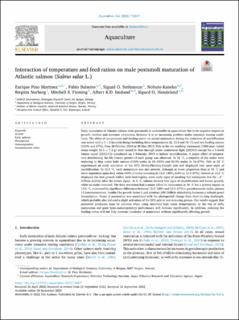Interaction of temperature and feed ration on male postsmolt maturation of Atlantic salmon (Salmo salar L.)
Pino Martinez, Enrique; Balseiro Vigo, Pablo; Stefansson, Sigurd Olav; Kaneko, Nobuto; Norberg, Birgitta; Fleming, Mitchell Stewart; Imsland, Albert; Handeland, Sigurd Olav
Peer reviewed, Journal article
Published version
Permanent lenke
https://hdl.handle.net/11250/3076498Utgivelsesdato
2023Metadata
Vis full innførselSamlinger
- Articles [3012]
- Publikasjoner fra CRIStin [3070]
Sammendrag
Early maturation of Atlantic salmon male postsmolts is undesirable in aquaculture due to its negative impact on growth, welfare and seawater adaptation, however it is an increasing problem under intensive rearing conditions. The effect of temperature and feeding ration on sexual maturation during the induction of smoltification was tested with a 3 × 2 factorial design including three temperatures (8, 12.5 and 18 °C) and two feeding rations (100% and 67%), from 28 October 2018 to 30 May 2019. Fish in the six resulting treatments (1800 parr, initial mean weight 23.1 ± 7.2 g) were reared in flow-through under continuous light (LD24:0) except for a 5-week winter signal (LD12:12) introduced on 4 February 2019 to induce smoltification. A major effect of temperature determining the life history pattern of each group was observed. At 18 °C, a majority of the males were maturing in May under both rations (100% males in 18–100% and 88.9% males in 18–67%). Fish at 18 °C experienced an early activation of the BPG (Brain-Pituitary-Gonad) axis and displayed very poor signs of smoltification. At 12.5 °C, early maturation was also present, although at lower proportion than at 18 °C and more dependent upon feed ration (40% of males maturing in 12.5–100%, 8.6% in 12.5–67%). Salmon at 12.5 °C displayed the best growth within each feed regime, some early signs of smolting but subsequent low Na+, K+- ATPase activity after the winter signal. At 8 °C, salmon showed best signs of smoltification and lowest growth, while no males matured. The feed restriction had a minor effect on maturation at 18 °C but a greater impact at 12.5 °C, evidenced by significant differences between 12.5–100% and 12.5–67% in gonadosomatic index, plasma 11-ketotestosterone, insulin-like growth factor-I, and pituitary fshb (follicle stimulating hormone β-subunit gene) transcription. Onset of maturation was associated with the photoperiod change from short to long daylength, which probably also induced a slight activation of the BPG axis in non-maturing groups. Our results suggest that postsmolt producers must be cautious when using sustained high water temperatures, or the risk of early maturation and poor hypo-osmoregulatory performance will increase significantly. In addition, reducing the feeding ration will not help decrease incidence of maturation without significantly affecting growth.
